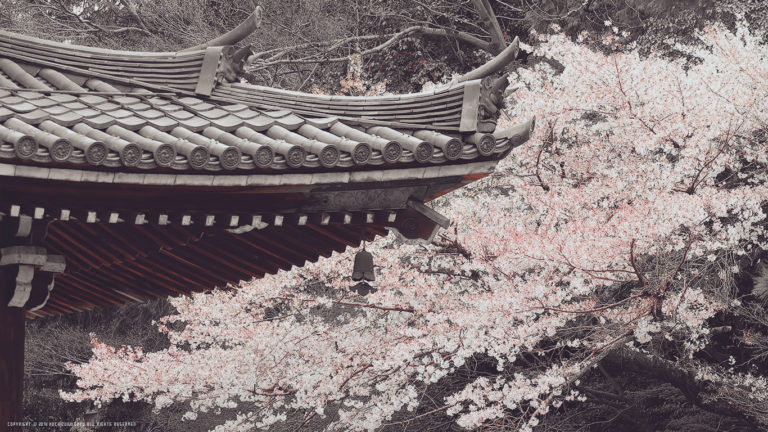
Image by Mochizuki Kaoru/Flickr (CC BY-NC-ND 2.0)..
Sacred Spaces Within and Without
The famed journalist and chronicler Pico Iyer wrote an essay entitled “Where Silence Is Sacred” that resonates with me to this day. It was a decidedly non-secular approach to a secular topic; how does someone, living in these warp speed, hyper-connected times find spiritual solace?
Iyer talks about the importance of chapels, especially in today’s frenetic world:
“So much of our time is spent running from ourselves, or hiding from the world; a chapel brings us back to the source, in ourselves and in the larger sense of self.”
Chapels allow us a refuge and a place not to disconnect but perhaps to connect with what is most important to us.
He talks about how he left the frenzied world of journalism for a monastery in Kyoto, Japan to learn about silence and “who (he) was when (he) wasn’t thinking about it.” Iyer returned to that monastery time and again over the next several years and also sought out other spiritual refuges.
Like Iyer, I long held an interest in sacred spaces. However, while I was drawn to the most compassionate elements of various faiths, I had a hard time justifying my interest in sacred spaces to myself. In my professional and personal life I spent much of my time thinking about how people could elevate humanity rather than dwelling on divine intervention. I convinced myself that my attraction to certain sacred spaces had more to do with my interest in their architectural and historical significance rather than their religious or spiritual significance.

I particularly struggled to explain the strange combination of awe and calmness that washed over me when I entered the Baha’i Lotus Temple in Delhi or the Vatican in Rome. I wondered if my feelings were triggered by a specific attribute of these physical spaces — cool marble, vaulted ceilings — or whether they were more a result of my mental space. Was it because traveling to these places took me away from my everyday stresses? If so, was it impossible for me to access that feeling of profound calm and oneness in my cramped apartment, in the midst of my very hyper-connected life in New York City?
Iyer addressed this fundamental question by recreating the conditions of his spiritual refuge in his home, quite literally. Dissatisfied with only having access to precious “silence” during his visits to the monastery, Iyer fashioned his home after it — with only the most basic amenities, eschewing television and internet access.
Ironically, while Iyer sought silence to channel his spiritual solace, it was through music that I heard the resounding echoes of Iyer’s sentiment in the gorgeous song “Cathedrals” by the band Jump Little Children. Pulsing through my headphones was the song’s haunting chords and refrain:
In the cathedrals of New York and Rome
There is a feeling that you should just go home
And spend a lifetime finding out just where that is.
I listened to this song when I was feeling particularly despondent or as I lay in bed, somewhere between wakefulness and sleep. It seemed to evoke a sense of being so small next to something so big, a feeling of surrender, which was the core of what I felt when I sat in the pews or walked through some of the most revered places of worship.
Unlike Iyer when it comes to seeking spiritual solace, I cannot unplug so completely — away from or at home. I look at friends who have gone on weeklong Vipassana Meditation silent retreats, with a mix of admiration and puzzlement. Quite frankly, an unplugged home is not a home to me. A few years ago, I went about trying to see if I could integrate a meaningful spiritual practice into my life in the middle of one of the most hyperactive cities, alongside the many devices that kept me connected to traditional and social media.
I took meditation courses that taught me how to focus on a candle or while walking, but it seemed to me that meditating was the last thing one should do when navigating the chaotic streets of New York City. I took yoga classes at a few different places but found myself often disenchanted because some of them created inhospitable conditions through extremely high temperatures, unnecessary aerobic elements, or through inadvertently fostering competition amongst students.
At the same time, I knew I hadn’t given any of these options enough of a chance. Soon, I began to feel disappointed that I hadn’t made inroads on something I considered integral to leading a meaningful life.

This wasn’t completely true, though. In fact, I have managed, albeit in a very small way, to create a daily spiritual practice. Every morning at the end of my shower, I lift my face up towards the shower head, close my eyes, and place my hands over my heart and let the water rush over me while reciting the following Sanskrit verse from the Upanishads, an ancient Hindu text:
Om Asato Ma Sad Gamaya
Tamaso Ma Jyotir Gamaya
Mrityor Ma Amritam Gamaya
Om Shanti Shanti Shanti
This roughly translates to:
Lead us from the Unreal to the Real
Lead us from darkness to Light
Lead us from the fear of Death, to Knowledge of Immortality
Let there be Peace, Peace, Peace.
I had come across this verse a few times over the years. But it finally stuck in my head after hearing it chanted by my parents and other members of their weekly meditation group. Perhaps hearing it resonate through the voices of committed, spiritual practitioners helped it lodge itself in my mind, heart, and soul. I love the meaning of the words. The verse seems like the perfect way to prepare myself for going out into the world each day, an everyday task that can sometimes feel Herculean, especially in this city. But I find that I also love saying the words, the way the syllables and consonants feel as they leave my tongue and mouth and echo off the walls of my watery “chapel.”

It turns out that Iyer’s spiritual practice was also tested, but in a very different way. His sacred refuge burned down, leaving him deeply saddened but also wondering:
“Where does one go when one’s chapel is reduced to ash? Perhaps it is the first and main question before us all.”
Fortunately, Iyer found that he was able to access it because he “had reconstituted the chapel in (his) head, (his) heart; it was where (he) went to be held by something profound.”
I’m not sure if it was because of or in spite of my quest, but my chapel quietly found me and erected itself in a small but perfect space in my life — one of washing away the last day and preparing for the one ahead. While this might not be the profound spiritual practice I had envisioned — and I certainly don’t lead an unplugged life and don’t expect to for some time — it suffices for now. For one moment each day, in my narrow New York City bathtub, I acknowledge my place in the universe while surrendering to whatever force governs our lives.
